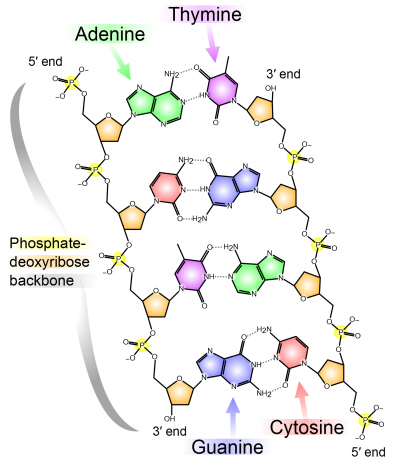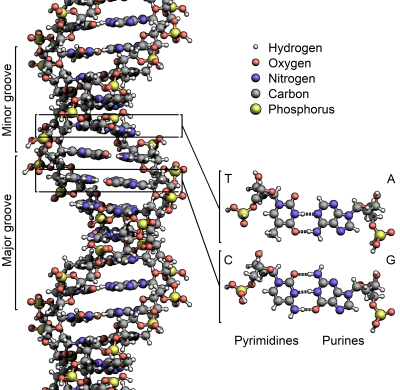Difference between revisions of "DNA"
| (5 intermediate revisions by the same user not shown) | |||
| Line 1: | Line 1: | ||
| − | DNA contains the vast majority of genetic information that is transmitted between generations in the form of a base pair sequence. | + | DNA contains the vast majority of genetic information that is transmitted between generations in the form of a base pair sequence (for exceptions see the [[central dogma of molecular genetics]]). |
| − | + | DNA is made up of a sequence (polymer) of four major base pairs ([[A]], [[C]], [[G]], and [[T]]). (C can be methylated, changing its function.) (Synthetic base pairs have been created that also function as a part of a DNA sequence.) These nitrogenous bases are covalently bonded to a deoxyribose sugar, which in turn is bound to a phosphate group. The phosphate group is also bound to the next sugar forming an alternating deoxyribose-sugar backbone supporting the base pair sequence. | |
| − | + | [[File:DNA chemical structure.png|400px]] | |
| − | + | DNA is typically present in the cell as doubled anti-parallel (running in opposite directions) strands that are connected with hydrogen bonds according to the base pairing rule (A-T and C-G). By convention only a single sequence of DNA is written down (because the alternate strand can be fully determined from one sequence) and it is written in the 5' to 3' direction (referring to the orientation of the sugar groups in the sugar-phosphate backbone) unless specifically indicated otherwise. Thus, 5'-ATGCATGC-3' is equivalent to ATGCATGC or (on the opposite strand) GCATGCAT. ATGCATGC is not equivalent to 3'-ATGCATGC-5'. | |
| − | + | [[File:DNA Structure+Key+Labelled.pn NoBB.png|400px]] | |
| − | [[DAPI]] is a commonly used fluorescent stain of DNA. | + | [[DAPI]] is a commonly used fluorescent stain of DNA to detect the presence of DNA in various samples. |
| − | [[Category:Basic Knowledge]] | + | [[Category:Basic Knowledge]][[Category:Molecular Genetics]] |
Latest revision as of 03:22, 17 July 2014
DNA contains the vast majority of genetic information that is transmitted between generations in the form of a base pair sequence (for exceptions see the central dogma of molecular genetics).
DNA is made up of a sequence (polymer) of four major base pairs (A, C, G, and T). (C can be methylated, changing its function.) (Synthetic base pairs have been created that also function as a part of a DNA sequence.) These nitrogenous bases are covalently bonded to a deoxyribose sugar, which in turn is bound to a phosphate group. The phosphate group is also bound to the next sugar forming an alternating deoxyribose-sugar backbone supporting the base pair sequence.
DNA is typically present in the cell as doubled anti-parallel (running in opposite directions) strands that are connected with hydrogen bonds according to the base pairing rule (A-T and C-G). By convention only a single sequence of DNA is written down (because the alternate strand can be fully determined from one sequence) and it is written in the 5' to 3' direction (referring to the orientation of the sugar groups in the sugar-phosphate backbone) unless specifically indicated otherwise. Thus, 5'-ATGCATGC-3' is equivalent to ATGCATGC or (on the opposite strand) GCATGCAT. ATGCATGC is not equivalent to 3'-ATGCATGC-5'.
DAPI is a commonly used fluorescent stain of DNA to detect the presence of DNA in various samples.

